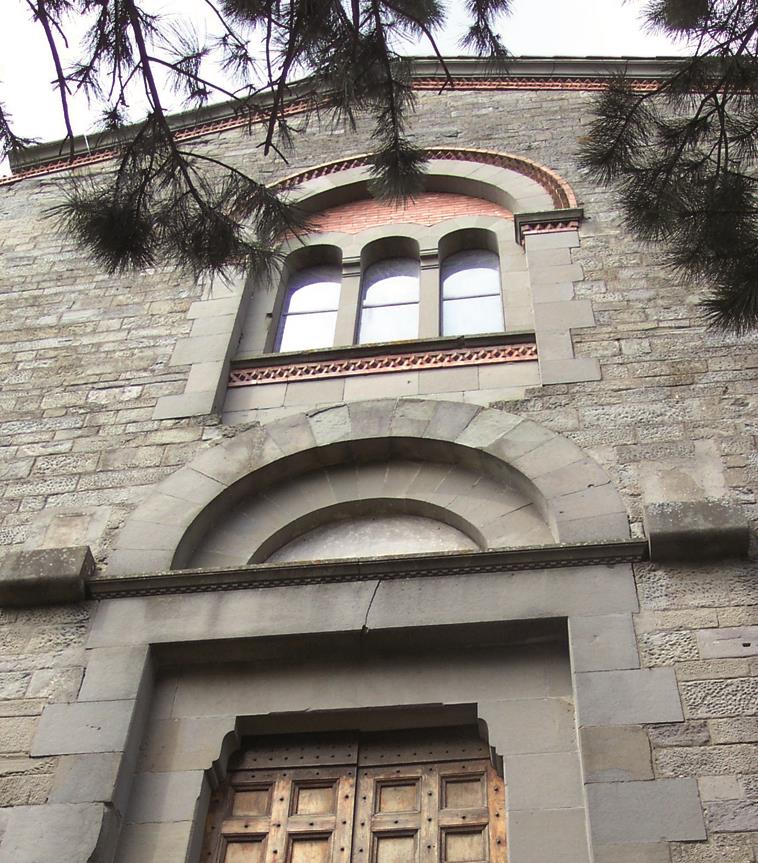The Church of Saint Peter in Cavarzano is located in the hamlet of Cavarzano, Vernio, in the province of Prato. This large neo-Romanesque church dominates the town. It was built to a design by Raffaello Franci between 1928 and1930, in sandstone and brick, after the demolition of the old church. The bell tower in nineteenth century style, was added in 1952. The high, wide entrance hall terminates in a semi-circular shape. Prior to the restoration of the monumental stone façade, the building was in a precarious state. Splits in the lintel over the main door and land movement caused overlaying sections to detach from their support. Most surfaces showed discoloration owing to factors of various origin (physical, chemical and structural).
The state of alteration and localized deposits was caused by a variety of environmental factors such as rain, humidity, extremes in temperature, lichens and fungi. This state of surface dilapidation and lack of maintenance presented serious problems. The conditions caused by weather and climate changes that affected the durability of brick and stonework had permitted humidity to penetrate and cause unnaturally low temperatures within the building.
Cleaning was carried out with deionized water spray, absorbent clay compresses and adequate neutralizing liquids such as quaternary ammonium were used. Disintegrating material was treated with the necessary application of the appropriate products for consolidation. The end result is a clean stone surface, homogeneous in appearance, smooth and free from micro-fractures and abrasions that could affect the status of the structure in future. At the same time the natural patina of the building has been preserved.
METHODS OF INTERVENTION
During research into the state of conservation investigations were carried out to check for any extensive detachments of material and overall stability. In the delicate cleaning operation vacuums and brushes with soft bristles were used to remove all loose dust present in the gaps. It was advisable to implement a removal of stains where necessary. This provided the preliminary analysis of the type of substance and the degree of penetration to be dealt with. Compatible water-based and ecological extractors were used.
Washing was carried out with deionized water sprays at low pressure through special nozzles positioned at a height followed by massage with soft brushes of natural materials. The treatment was carried out at external temperatures not exceeding 14 ° C. The removal of unstable and decayed grouting was made with skilful use of scalpel, hammer, and small chisels. Localized compresses based on absorbent clay (attapulgite, sepiolite or similar) diluted with a mixture of deionized or distilled water were used to coat surfaces that had been dampened prior to treatment. The percentage of humidity was maintained constant by means of polyethylene sheets which prevented premature evaporation.
The replacement of disintegrated grouting previously removed was done with putty lime (slaked and mixed with natural hydraulic lime and sand aggregate). Pigments were added to achieve the same colour as the original mortar. The micro cracks were sealed with specific compatible fillers and the application of consolidating liquids. Reintegration of missing parts was carried out. Those sections detached or damaged beyond repair, were replaced by like parts, and fixed by bridging in epoxy resins. Subsequent plastering with mortar containing added pigment in order for it to colour match the original material.
A reversible consolidating material compatible in composition to the morphological and colour characteristics of the support, highly elastic, water-repellent, breathable, UV resistant and colourless was applied. The application was performed by impregnating the capillary cracks, by percolation and with the use of swabs to keep the surface moist for the whole duration of the intervention.
Gallery


